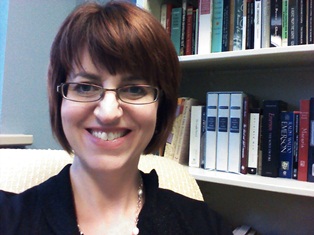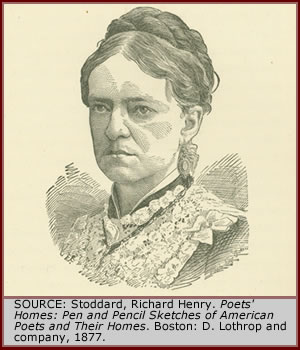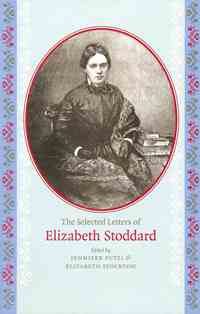GSWS professor discovers missing letters by nineteenth-century writer
 When GSWS professor Jennifer Putzi realized she had stumbled on some forgotten letters by nineteenth-century American writer Elizabeth Stoddard, she was “giddy with excitement.” Putzi was not even researching Stoddard at the time, but when she read the unsigned correspondence – published in the San Francisco Bulletin in the 1860s – she “just knew it was Elizabeth Stoddard. Her voice is so distinctive.”
When GSWS professor Jennifer Putzi realized she had stumbled on some forgotten letters by nineteenth-century American writer Elizabeth Stoddard, she was “giddy with excitement.” Putzi was not even researching Stoddard at the time, but when she read the unsigned correspondence – published in the San Francisco Bulletin in the 1860s – she “just knew it was Elizabeth Stoddard. Her voice is so distinctive.”
And if anyone can recognize Stoddard’s voice, it’s Putzi. Already one of the world experts on Elizabeth Stoddard (she is the co-editor not only of the recent Selected Letters but also of Stoddard’s 1865 novel Two Men), Putzi knows more about Stoddard than almost anyone – except perhaps her co-editor on the letters, Elizabeth Stockton.
Until recently, people who recognized Elizabeth Stoddard’s name probably knew her as the wife of poet and critic Richard Stoddard, rather than as a popular writer in her own right. But Elizabeth Stoddard (1823-1901) was prolific, publishing novels, stories, poems and “newspaper letters” well into her old age. Putzi is proud of bringing Elizabeth Stoddard back to prominence after so long in the shadows. “Elizabeth Stoddard’s letters are more than a series of entertaining – and sometimes very moving – texts,” Putzi notes. They are also a window into the literary and cultural history of New York City in the second half of the nineteenth century, and into the life of a Victorian working mother.
 Putzi explains that she and Stockton had to make some difficult decisions about which parts of that history to include, and which to leave out. Of those seven hundred letters, they were able to include only eighty-four – just twelve percent. They decided to choose letters that formed clusters – the newspaper letters about the Civil War, for example – while at the same time giving readers a sense of the range of Stoddard’s opinions and personality. “She was famously acerbic,” notes Putzi, “and a number of her friendships ended because of her difficult personality.” But working on the letters convinced Putzi that Stoddard also had a fierce capacity for devotion and loyalty, especially to her husband and to her three sons, all of whom predeceased Stoddard and her husband.
Putzi explains that she and Stockton had to make some difficult decisions about which parts of that history to include, and which to leave out. Of those seven hundred letters, they were able to include only eighty-four – just twelve percent. They decided to choose letters that formed clusters – the newspaper letters about the Civil War, for example – while at the same time giving readers a sense of the range of Stoddard’s opinions and personality. “She was famously acerbic,” notes Putzi, “and a number of her friendships ended because of her difficult personality.” But working on the letters convinced Putzi that Stoddard also had a fierce capacity for devotion and loyalty, especially to her husband and to her three sons, all of whom predeceased Stoddard and her husband.
Working on the anguished letters that were written during and after the illnesses and deaths of those children was one of the most painful aspects of the edition, Putzi acknowledges. The Stoddards’ eldest son, Willy, died at the age of six; a second unnamed child died in infancy; and a third son, Lorry, survived into adulthood but then died shortly before his parents of tuberculosis. “Elizabeth and I were having our own children while we were working on the edition,” says Putzi, “so it was hard not to be affected by the intensity of Stoddard’s grief.”
Putzi and Stockton decided to collaborate on a selection of Stoddard’s letters several years ago, when they saw that interest in her was growing. “We know of at least seven hundred letters by Stoddard scattered in archives and attics all around the country,” said Putzi. “We felt sure that people would be interested in reading them, but until some of them were published, it was really difficult to do that.” One exciting find came as a result of a William & Mary connection. An online search turned up a colleague at the Marshall-Wythe School of Law, Chuck Hobson, who is a descendant of Bayard Taylor, a friend of Richard Stoddard’s. That contact led to the discovery of three previously unknown letters from Elizabeth Stoddard to Taylor’s family, one of which Putzi and Stockton included in their volume.
 “It was a true collaboration between me and my co-editor,” Putzi explains. She and Stockton shared out the letters, visited archives to transcribe them, checked each other’s transcriptions against copies, and then drafted and re-drafted all the annotations, passing them back and forth until they were both completely satisfied. “We did the same thing with every word that is in the book,” notes Putzi.
“It was a true collaboration between me and my co-editor,” Putzi explains. She and Stockton shared out the letters, visited archives to transcribe them, checked each other’s transcriptions against copies, and then drafted and re-drafted all the annotations, passing them back and forth until they were both completely satisfied. “We did the same thing with every word that is in the book,” notes Putzi.
And the book offers plenty of help to readers who are less familiar with Elizabeth Stoddard. The University of Iowa Press generously allowed Putzi and Stockton to include all the supporting material they felt was necessary: an introduction, a timeline of Stoddard’s life, biographical notes on her correspondents, and extensive notes explaining confusing or unfamiliar references in the letters. “Everyone told us we would never find a press,” Putzi remarks, “but in the end several presses were eager to publish the book.” One prominent critic of American literature called it a “must-read.”
So what’s next? Putzi says she is not sure she wants to go on to write a biography of Elizabeth Stoddard. Reading all those letters convinced her that, like all of us, even at her most intimate Stoddard was mindful of an audience. We will never know who she really was. Ironically enough, Putzi is now working on a book that questions the idea of authorship in the nineteenth century. Stoddard would have approved. “Your letter saddens me,” she wrote to a friend in 1867. “Like some other readers, you are led to my personality.” But with a personality as incisive and intriguing as Stoddard’s, one can understand how that might happen – and Putzi and Stockton have paved the way.














